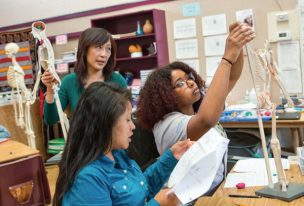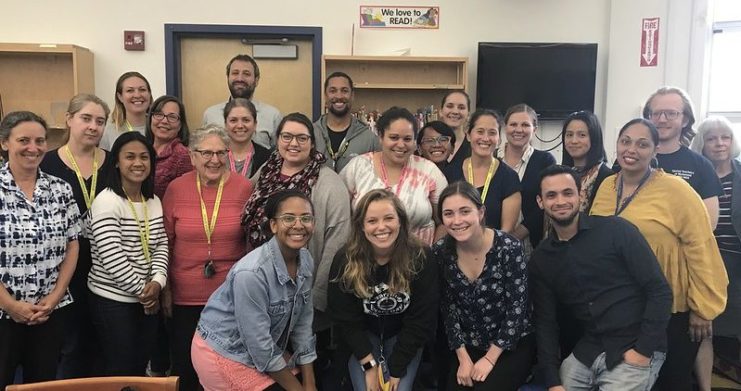
Partnering with Teachers to Build a Transformative Culture of Adult Learning
Katherine Acosta-Verprauskus, Principal at Montalvin Manor K-8 in West Contra Costa Unified School District shared her leadership journey at our Inquiry in Action Webinar on March 26, 2020.
In the Beginning
Montalvin teachers and I have worked with Mills Teacher Scholars for four years and in that process we have built a strong adult learning culture that’s leading to accelerated student achievement. This isn’t the trend in schools like ours, though – Title 1 schools serving predominantly English Learners where 90% of students receive free and reduced lunch. It didn’t all happen overnight or even over a year. We’ve been on a journey, one of shifting mindsets and practices. I’ll be sharing with you how we got there.
Seven years ago, when I walked into Montalvin as the new principal, collaboration looked very different. Teachers planned in their classrooms, and never really came together as a team except for the traditional monthly faculty meetings. As a leader my vision was very different. I believe that adults do their best when they work together, and I knew change needed to happen. To make dramatic gains for our students we had to truly collaborate – lean on each other, hold each other accountable, and learn from one another.
But in that first year, my learning curve was really high. I felt really alone as a principal running around like crazy during the day and staying up into the wee hours of the night planning PD, completing paperwork, and learning how to do school budgets. I couldn’t hold it on my own and I didn’t have to. I had many teacher leaders whose expertise I deeply valued and who I quickly leaned on in order to do the work well. Together, we determined that collaboration time needed to be intentional, down to the minute, and that the time needed to be together in the library where we could see all teams working together.
In that first year we accomplished the togetherness part of collaboration. It wasn’t until the second year that teachers actually led these meetings, but it was really messy. I handed over the facilitation to teachers leaders, but I didn’t give them any training or support! Turns out running a meeting with kids all day is very different than facilitating a meeting with adults in the afternoon! We knew we needed help but we decided to muddle through it that year.
It wasn’t until my third year that we reached out to Mills Teacher Scholars for support. They were able to guide us through a process that may seem obvious but in practice actually isn’t. One of our values is that everyone is a learner at Montalvin – and that absolutely includes me. It’s hard to be a facilitator and a participant. Mills Teacher Scholars was able to provide high quality structure, accountability, and allowed me the opportunity to join in with my teacher and do the collaboration. Even on the craziest days, the ones where I felt like there were 100 office referrals, a line of angry parents, and a pop-in visit from the superintendent, I knew that collaboration on our Mills Wednesday was going to be high quality and translate to great things for kids the next day. Perhaps most importantly, in that first year with Mills Teacher Scholars, our teacher leaders were finally able to cultivate the skills to plan and facilitate meetings with their colleagues.
Slowly Shifting Mindsets and Practices
But change takes time and I would say the hardest shift for us was the concept of perfection. Our teachers wanted to be the best and only show the best even amongst their closest colleagues. It took time to dismantle this mindset. To do the best for our kids, we had to talk about our most imperfect moments – the ones you never want to talk about. In the past 4 years we’ve been focusing on exactly this with Mills Teacher Scholars. We’ve been slowly shifting the mindset from perfection to reality – we are all learners, we make mistakes, and that’s where the learning happens. One structure that quickly moved us there was the public learner model. Teachers sharing problems from their classroom and asking for help in thinking about that problem differently. Through this we built a strong professional culture of empathy and mutual support for one another. Showing vulnerability with one another instead of trying to prove our worth.
After that first year, we got a lot of great feedback from the staff, and we also got some push back. Particularly that the collaboration protocols were feeling too rigid. It could have been easy to just throw it out, but we knew that they were there to keep us accountable to placing student data at the center of our conversations. It was also really important to creating an equitable talking space. Without these protocols, the loudest voices would have taken over. We wanted to hear everyone and everyone needed to feel like they were learning. Instead of doing away with it, we chose to keep it in place, but we took the time to better explain the “why” behind protocols to our team.
Another development over our years has been our dedication to analyzing student work. Listening to what students are saying, seeing videos of student talk, and studying their mistakes. We went from saying, “This is what I’m doing in my classroom,” to “Take a look at Jimmy’s writing. How can I get him to elaborate here?” Teachers were getting feedback from their team that they could implement the very next day.
Now at the end of our 4th year, inquiry at Montalvin is not just a structure owned by Mills Teacher Scholars, it’s become an internalized process that we refer to as the Montalvin Problem of Practice. No, it doesn’t mean we no longer partner with Mills Teacher Scholars – because we do, but the process is so ingrained in what we do that it is just the Montalvin way. It’s our teacher leaders facilitating the same protocols we learned in year one and now enhanced with peer observations, instructional rounds, and end-of-year inquiry presentations.
When we first started this collaboration journey, our big goal was “Let’s get together.” We moved from there into, “Let’s think about what our kids need and how to work as a collective to get there.” Instead of everyone working on their own individual interests, we are all leaning on each other to work towards a shared goal for student learning.
We invest time before the beginning of each school year to collectively envision our goals as an entire staff. We look at student achievement data and consider where to place our collective efforts.
The Data: Student Achievement
And this all sounds pretty, right? but you might be wondering, to what end? I’m really excited to share that we’ve seen some amazing results in the hardest way possible to show – school wide student achievement. Three years ago our collective inquiry goal was focused on supporting growth with English Language Learners and by the end of that year we had reclassified 40 EL students. That’s 15 more than in years prior. Two years ago we chose the area of intervention in literacy and in the past few years, our SBAC ELA scores have outperformed our similar schools.
If you are on this call today, there’s a good chance you like student data, so let’s take a look at some of our numbers. It’s SBAC data, but presented a bit differently – This is our CORE data, it shows status and change, a fundamentally more meaningful measure of a school’s academic impact. Instead of looking at a group of 4th graders last year and comparing that score to this year’s 4th graders like the state dashboard does – the CORE dashboard takes historical data and looks at last year’s 4th graders and how they achieved as 5th graders this year – seeing actual student growth and helping us to measure our collective impact.
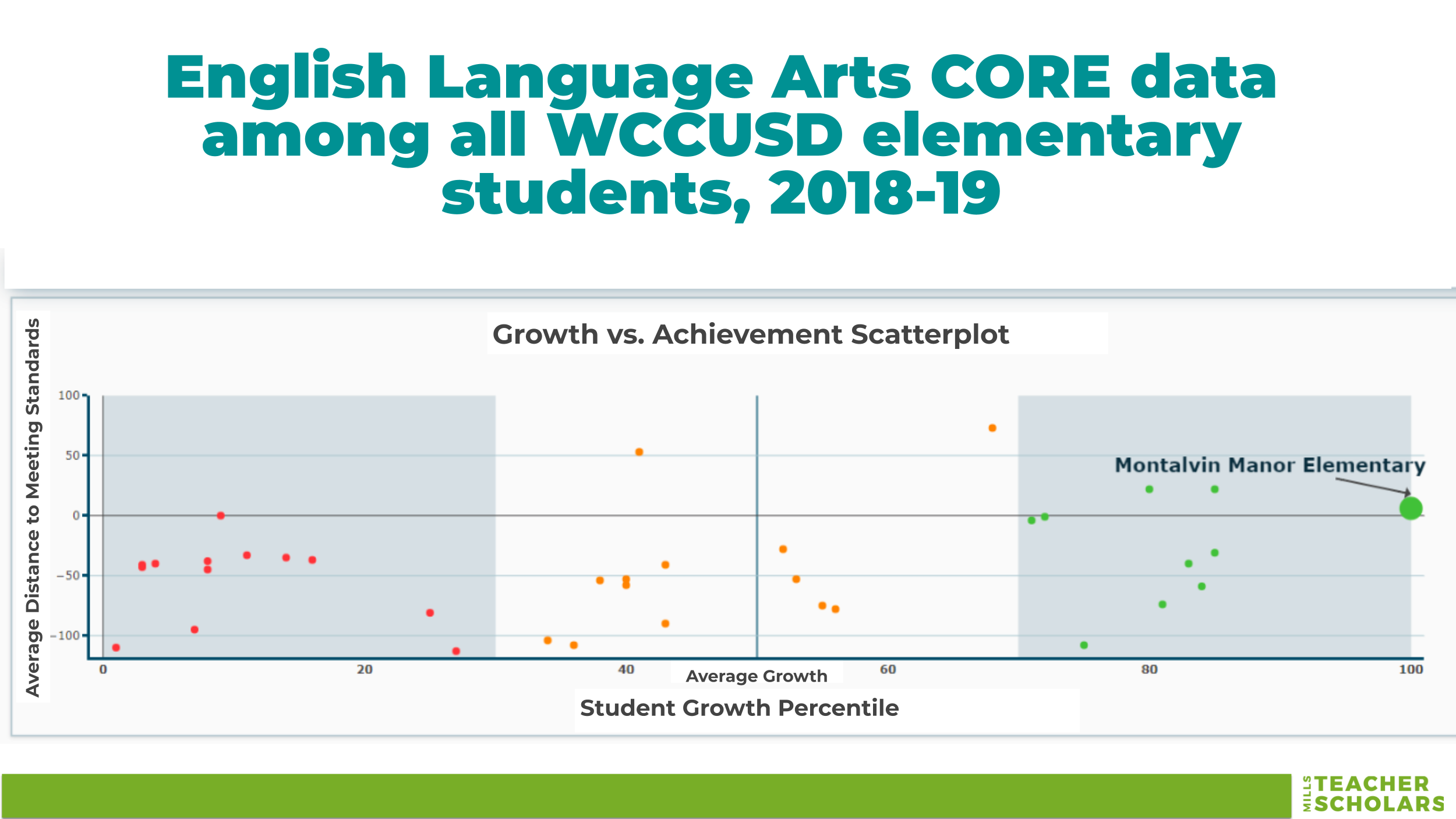
This is the collective data for elementary schools in our entire district, every dot is a school, a very diverse mix of low and high income schools spanning several cities in West Contra Costa, ranging from Stege and Lincoln elementary school, to Madera and Kensington Elementary. Along the y-axis, we can see how much students know. Along the x-axis, we can see how much students grow relative to their peers. Schools represented on the far left below in red dots, are both low performing and low growth schools. In the middle, you see average growth schools in orange. On the far right, you will see the green schools. Schools where students are growing at a much higher pace than others. Mostly high needs schools, including Montalvin, all clearly being intentional about learning and dramatically beating the odds for growth.
Our literacy growth percentile is 100, making us the fastest growing school in the district. Taking a look at the Math scatter plot, you’ll see a similar format, with noticeable less schools in the green – but there we are again in the green with a Montalvin growth percentile of 71. Not fully where we want to be yet with percent proficiency, but dang, our kids are maximizing their growth every year they are with us!
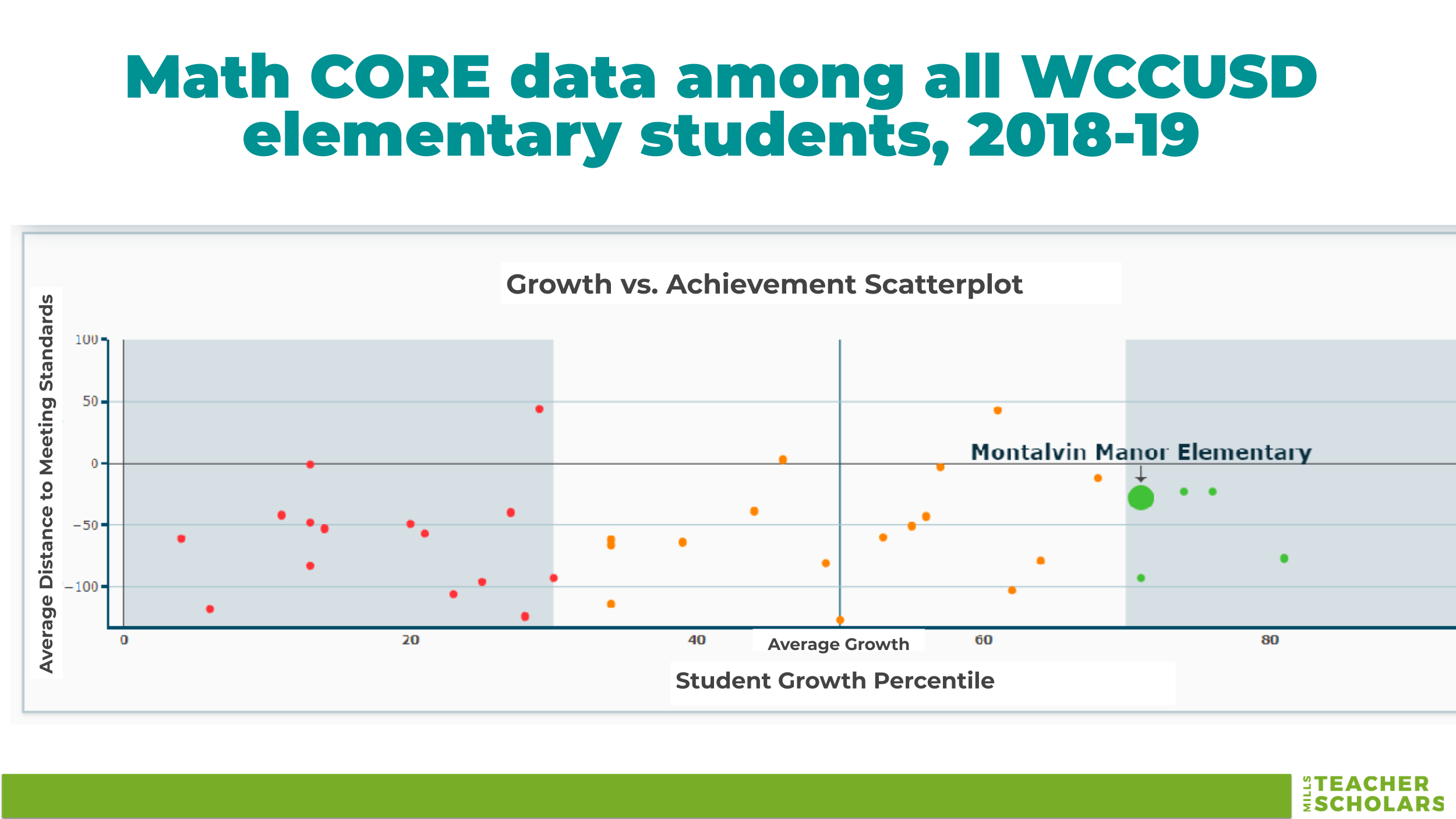
A Teaching Community That Works Together
But one thing that’s not fully captured is numbers, is the pride I see in our team. Our team shows up and they work hard. Our teachers like each other. They feel supported and challenged by their colleagues and the culture of learning has never been so strong. I would say this is most evident on a Wednesday at 1:30PM when the library is full and teachers across grade levels, gathered in tables organizing their student work or queuing their videos all eagerly waiting for collaboration to begin.
But I’m most proud at the end of the year, because this is when we do our inquiry presentations. Where every team member stands up with powerpoint presentation and all to tell their story of leaning for the year, truly professionalizing the process of inquiry. Last year, a group of teachers from another school visited on this day and one of them said, “Holy moly this is super professional, our school could not do this!” and my initial reaction was to laugh, because 4 years wasn’t that long ago – No gimmicks, just a team of teachers working hard together to make significant gains for their kids.
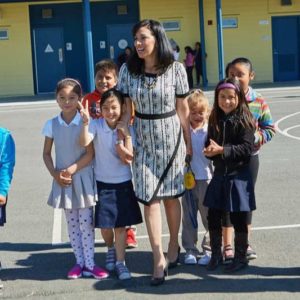 Katherine Acosta-Verprauskus
Katherine Acosta-Verprauskus
Principal
Born and raised in Lima, Peru and moved to Kansas when she was 10 years old. Katherine is a first-generation college student and earned her master’s and undergraduate degrees from the University of Kansas. She is dedicated to serving youth and supporting them to reach their goals and dreams. In the past, she has served as a vice-principal in a K-8th school in East Oakland and as a special education teacher at Lincoln Elementary School in WCCUSD. Ms. Acosta-Verprauskus values working in partnership with teachers, students, and families to maximize the learning and experience of ALL students at Montalvin Elementary School. In her spare time, she chases her 2-year-old son and enjoys cooking in her Richmond home.
This article was written in Spring 2020, Mills Teacher Scholars changed their name to Lead by Learning in the fall of 2020.

